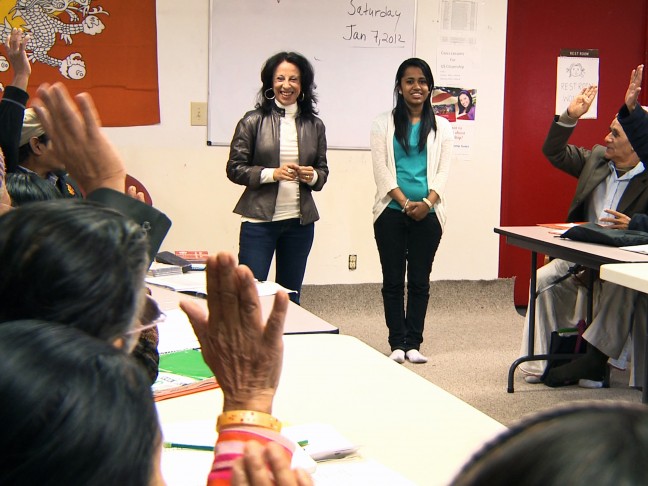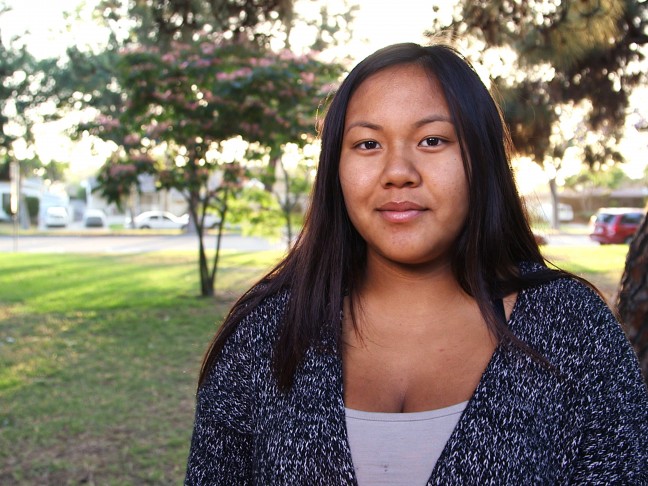Maria Hinojosa is used to being on the other side of the microphone, interviewing folks for her popular NPR show, Latino USA, and for the upcoming PBS series, America By The Numbers. The series takes an intimate look at of race and demographics in the U.S. through personal stories.
Hinojosa hosts the 8-episode series, which begins airing on PBS and World Channel October 2nd (check local listings). The pilot show of America By The Numbers, set in Clarkston, Georgia, aired on PBS a year ago. The Center for Asian American Media provided funding for the series, along with other organizations that are part of the National Minority Consortia. Hinojosa started her own media company, Futuro Media Group, four years ago to address the lack of diversity in mainstream media. Her company now produces the weekly Latino USA and America By The Numbers.
I had a chance to sit down with Hinojosa during a break at a school board meeting for America By The Numbers in Long Beach, CA. Hinojosa shares about why she became a journalist, growing up in “news-consuming Mexican immigrant family,” and why she formed her own media company.
– Momo Chang
What inspired you to become a journalist?
I was born in Mexico, and I was raised on the South Side of Chicago. I grew up in the middle of the Civil Rights Era, the Women’s Movement, the Chicano Movement, the Black Pride Movement. My family, even though we were from Mexico and were immigrants, we began consuming American news media. We would watch the evening news, my dad subscribed to TIME magazine, the radio was on all the time. We were a news-consuming Mexican immigrant family in Chicago. But we never saw ourselves, ever, reflected in the media. That, I think planted a seed in me to just say, hold on a second, I can’t be the only one experiencing this America that I’m living through. I think that experience of invisibility made me want to make things visible. So my whole career has been dedicated to making the invisible visible.
Why did you want to do this show?
In my history of working in most of the mainstream media, as somebody who grew up basically feeling like the “other” in American society, whenever I would propose a story about a community that was perceived to be “the other” and I’d come in and say, “Here’s this great story that’s happening in the Latino community, or the Asian community,” and oftentimes what would happen would be just like, “No, that’s not interesting.” Or, “I don’t know what you’re talking about, I’ve never heard about that.” Or, “Well, we did a similar story two months ago. Do we really have to revisit this?” And frankly, I got tired of hearing no, when I knew that there were these great stories that needed to be told about, quote-unquote, “the other America.”
Now you fast forward to the moment in the history that we’re living in right now, and it’s not the other America. This is the America that we’re living in—a completely, demographically transformative moment in American history. And yet because of the lack of diversity in most of our mainstream media, these stories about these communities were just not seen as American stories. So, that was my vision. I knew the numbers, I had been watching the numbers for the past 25 years. And it’s irrefutable that our country is going through one of the most massive demographic changes. So that’s why I formed my own company. And that’s why I decided to come up with a television series that would look at this demographic change and tell these untold stories about, quote-unquote, “minority communities,” which they are no longer minority communities.

What are the challenges of making a show about race in America?
To be honest with you, we are faced with challenges at very step of the way. It’s the challenge of raising the money, the challenge of finding the right team, the challenge of executing on a shoot like this one. It’s the challenge of convincing people that this is series that is important. I mean, at every step of the way, there are challenges. I guess the question is, “Where were you not challenged?” And I would say that in the belief that these stories need to be told.
What kind of impact do you hope to make?
I really want people to see themselves reflected on a national network, in news programs. I wanted it to be a series that came back every year to tell these stories. So I want to make an impact on journalism as well, in saying, this moment in history merits this kind of deep-drill journalism.
I want to inspire change. And I think that that’s a decent value for a journalist to have. The best news was that after our pilot aired from Clarkston, GA when we went back to do the update, we went back because for the first time ever, three former refugees decided to run for office. And they cited our television as one of the reasons that motivated them to run because they saw themselves on television talking about electoral politics and voters. So they said, “When we saw ourselves talking about this, we realized that we could do it.” That kind of change? That’s the best kind of change ever. Motivating people to do something in their lives. That’s democracy in action.
I always saw myself as building bridges. So it wasn’t just about Latino stories. It was telling untold stories of many different communities. That’s why I feel so honored that CAAM and the [National Minority Consortia] has decided to support this project. As one that has experienced a lot of invisibility, I think it was something that I was going to be able to identify with other communities.

Can we talk about the Long Beach episode (“Pass or Fail in Cambodian Town”)? Why challenge the Model Minority Myth?
Part of what we want to do is to challenge our viewers. We don’t want to tell the stories that others haven’t told, and we want to tell the backstory. We talked a lot about many different issues facing the Asian American community. But when our researcher team came up with this number—which is Southeast Asian dropouts are basically on part with Latino dropouts as the highest number in our country—I immediately said, “What? Where is this happening? And how come I’ve never read about this?” And frankly, everyone who I tell that we’re coming to do this story immediately just said, “What are you talking about? Asian dropouts?” So we want to bust stereotypes in every possible way. Once we came upon this story, we knew we wanted to tell it. And Long Beach being the heart of the Cambodian community here, it was clear that this is where we had to be.
For me in particular this story has been—because I’ve never done much reporting at all in the Cambodian community–I want to do it right, I want to be sensitive. This community is facing a lot of challenges. And it’s a real uphill. So I’m hoping that when we put this on the air, that something happens. And at least that this community finally feels visible and heard.
Is there anything else you want to add about the show?
The uplifting part is when you have young people like Shameka who are just unstoppable. She had everything going against her and then some. And you know, fingers crossed, she’s going to graduate. So everything is not a lost cause. So we want to highlight the challenges, the problems, the fact that no one talks about these dropout rates. But at the same time, particularly where we are right now—a school board meeting, a packed auditorium, an overflow room, and there are people who are sitting here in this meeting—they’re taking part in American democracy. This is amazing. This is great. So we have to document both sides of the story.
This interview has been edited for length and clarity.
Main image: Award-winning journalist Maria Hinojosa in Clarkston, Georgia. Photo by Paul de Lumen.




